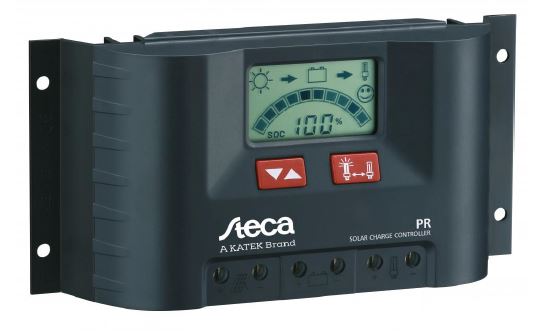SOLAR REGULATOR (Steca Solarix PR2020) 20A, 12/24V
Valid Article
SOLAR REGULATOR (Steca Solarix PR2020) 20A, 12/24V
Form
A solar regulator connects the output of photovoltaic (PV) solar panels to a battery system. It adapts the voltage-current levels at the input to the battery voltage, thus protecting the battery from overloading.
The Solarix PR2020 regulator is a PWM controller, i.e the battery charging voltage is controlled by pulse with modulation.
Simple menu-driven operation, programming by buttons.
Specifications:
- nominal system/battery voltage: 12 or 24 V
- max. current: 20 A
- max. PV Voc voltage: 47 V
- Multistage charging technology
- Terminal connectors: max. 16 mm²
- temperature range: -10 to +50°C
- protection:
- overcharge protection
- deep discharge protection
- reverse polarity protection of module, load and battery
- automatic electronic fuse
- short circuit protection of load and module
- overvoltage protection at module input
- overtemperature and overload protection
- dimensions (HxWxD): 187 x 96 x 44 mm
- weight: 0.35 kg
Per piece.
Fit
The solar regulator fits with solar panels up to 47 V (Voc) and currents up to 20 A.
The regulator can be used in systems with battery voltages of 12 V or 24 V.
Function
The basic function of a solar controller is to regulate the input voltage and current of the PV solar panels so that batteries can be charged with the correct voltage. Thus, it prevents batteries from being overcharged.
Additionally the Solarix solar regulator has a load output to which a DC electrical load can be connected. If the load output is used, the regulator controls the discharge of the battery and an overload on the output side can be avoided.


![[KCOMKSOLR--] KIT, SOLAR, for radio room, with batteries](/web/image/product.template/548180/image_256/%5BKCOMKSOLR--%5D%20KIT%2C%20SOLAR%2C%20for%20radio%20room%2C%20with%20batteries?unique=0463ffc)